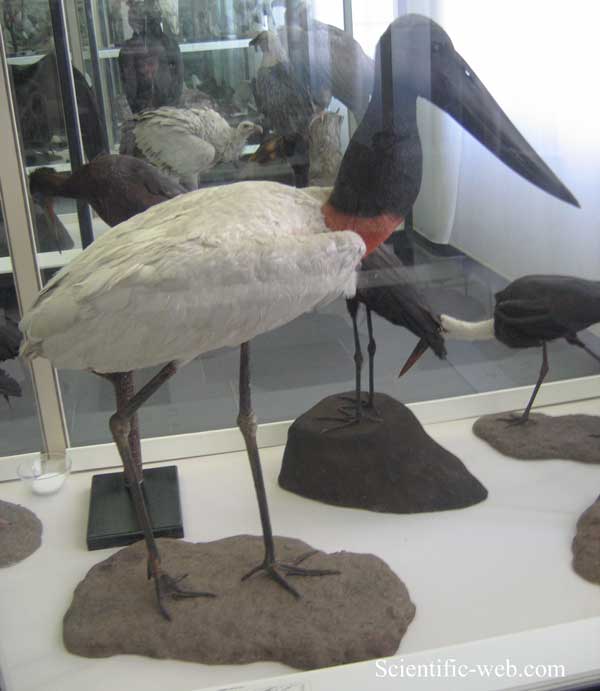Jabiru mycteria, Photo: Michael Lahanas Cladus: Eukaryota Name Jabiru mycteria (Lichtenstein, 1819) Vernacular names
* Abhandlungen der physikalischen (-mathematischen) Klasse der Koeniglich-Preussischen Akademie der Wissenschaften. (1816-1817) p.163 ------ The Jabiru (Jabiru mycteria) is a large stork found in the Americas from Mexico to Argentina, except west of the Andes. It is most common in the Pantanal region of Brazil and the Eastern Chaco region of Paraguay. It is the only member of the genus Jabiru. The name comes from the Tupi-Guaraní language and means "swollen neck". The name Jabiru has also been used for two other birds of a distinct genus: the Asian Black-necked Stork (Ephippiorhynchus asiaticus), commonly called "Jabiru" in Australia; and sometimes also for the Saddle-billed Stork (Ephippiorhynchus senegalensis) of sub-Saharan Africa. In particular, Gardiner's Egyptian hieroglyph G29, believed to depict an E. senegalensis, is sometimes labeled "Jabiru" in hieroglyph lists. In Portuguese, the bird is called jabiru, jaburu, tuiuiu, tuim-de-papo-vermelho ("red-necked tuim", in Mato Grosso) and cauauá (in the Amazon Basin). The name tuiuiu is also used in southern Brazil for the Wood Stork (Mycteria americana). The proposed Late Pleistocene fossil stork genus Prociconia from Brazil might actually belong in Jabiru. A fossil species of jabiru was found in the early Pliocene Codore Formation near Urumaco, Venezuela (Walsh & Sánchez 2008). Description The Jabiru is the tallest flying bird found in South America and Central America, often standing around the same height as the flightless and much heavier American Rhea. The adult Jabiru is typically 122–140 cm (48-55 in), 230-280 cm (90-111 in) across the wings, and weighs to 8 kg (17.6 lbs). The larger males may stand as tall as 1.5 m (5 feet). The beak, up to 30 cm (1 ft) long, is black and broad, slightly upturned, ending in a sharp point. The plumage is mostly white, but the head and upper neck are featherless and black, with a featherless red stretchable pouch at the base. The sexes are similar, although the female is usually smaller than the male. While it is an ungainly bird on the ground, the Jabiru is a powerful and graceful flier. Habits The Jabiru lives in large groups near rivers and ponds, and eats prodigious quantities of fish, molluscs, and amphibians. It will occasionally eat reptiles and small mammals. It will even eat fresh carrion and dead fish, such as those that die during dry spells, and thus help maintain the quality of isolated bodies of water. References * BirdLife International (2008). Jabiru mycteria. In: IUCN 2008. IUCN Red List of Threatened Species. Downloaded on 3 February 2009. Database entry includes justification for why this species is of least concern. * Walsh, S. A. & Sánchez, R. 2008. The first Cenozoic fossil bird from Venezuela. Paläontologische Zeitschrift 82(2), 105-112. Source: Wikispecies, Wikipedia: All text is available under the terms of the GNU Free Documentation License |
|

